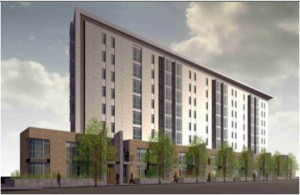Neighborhood Group Says No to Mercy Housing Lakefront’s East Side Development
Wednesday night the Greenwich Village Neighborhood Association held a meeting to discuss Mercy Housing Lakefront’s East Side apartment proposal. Alderman Kovac started the meeting out explaining that “the process begins now,” but if this meeting was any indication then it was the end as this project was voted down by the neighborhood group.
Mercy Housing Lakefront attempted to explain that this is really workforce housing, not low-income housing. Meaning that the vast majority of the units the household income levels could be as high as $45,000 a year. Lisa Kuklinski, of Mercy Housing Lakefront, stated that, “this proposal is for workforce housing, not Section 8 housing, and that tax credit development “subsidizes the buildings, not the people.” The building would have studio apartments starting at $325, and at the high-end three bedroom apartments which could rent for as much as $1,050 a month. Of the 83 units only eight would target entry-level wage earners, essentially people making about $10 an-hour, eight would target retail managers-level wage earners, and 67 units could include experienced technicians at Columbia St. Mary, entry-level teachers, and entry-level police officers.
Responding to questions regarding the impacts and benefits of the development David Lyon, regional director of housing development for Mercy Housing Lakefront, responded that the residents will be “living and spending their money” in the neighborhood. He added that “we pay full boat property taxes,” and Lisa Kuklinski followed up with “where we are present, the neighborhood has improved.” Additional, questions came up regarding the land sale process, the buildings height, parking, and traffic.
The group took an informal vote with the majority of the crowd voting against having the city continue on the path towards extending a purchase option. The vote appears to have had the desired impact of stalling or halting the project as had the project been moving forward at this point it was to be on the agenda for the March 22nd City Plan Commission meeting.






















Dave let me add to your report , that during the commentary my sense was that people were concerned about a couple of aspects of the proposal such as the size and design of the building and the necessary speed of the process, but not the concept of workforce housing in the neighborhood. If there is a word we can use to typify the sense of the majority, it was caution and because of Mercy’s need to expedite the land sale to qualify for WEDA funding, many felt there wasn’t enough time to negotiate,(A) a better design and (B) have a fuller debate. Most of all, I didn’t sense a lot of NIMBY attitude about serving workers from Columbia Saint Mary’s and the retail district..
@Jeff To be fair, yes it wasn’t as much about the “low-income,” as some meetings I’ve been to on other projects, though I heard plenty of comments regarding that aspect prior to the meeting at the bar. And a yes vote would not of approved the height, design or anything other can we continue working on this… so it did make me wonder. Though I do hear you on the process aspect, that in itself was a bit confusing, and quick.
Also I thought your comments were very nice…. and I do hope it wasn’t the workforce housing aspect that stopped this project.
What do you think it says about Milwaukee that developers mainly want to build downtown, or on the east side, or on Milwaukee’s other east side–but residents are consistently opposed to everything from high-end condos to “workforce” and retiree housing. And when I put it that way, we all know what it means in terms of race and class. Why can’t we get anything rolling in the south end of 53212, or up on the north end by Glendale? Do we need to take middle-class 50-60ish white east siders by the collar and say, “Hey, Milwaukee is bigger than the scope of your little concerns!”
(oops, hit ‘submit’ too soon.) …Or can they just be bypassed by growing elsewhere? What does it take to get past this perpetual impasse?
I think there are two issues with this submission. If Mercy could put effort into working with the NA’s on a decent building and make them feel like they have had input. And trust me, as a veteran of the Downer Street battle, I know that everyone will not be happy with any end product.
My observation is that East Siders, older and younger, have a problem with high rise. What people have not understood is that with a rise in Property values the only way to properly invest is to go up. It was pointed out that the single story building on the corner of Prospect on North was a mistake.
Her’s my 2 cents. The Mercy building was unusually tall because the first three floors are parking and the size and shape of the lot.. The addition of Townhouses on the Thomas street side serves to “step up” the design and soften the impact. All of us in the neighborhood know that virtually all of the parking ramps and lots sit empty for most of the day. Visitors seem to gravitate to free or metered on street parking. A partnership with the lot across the street at Whole Foods / CSM and a waiver on the parking requirement could produce a lower, more acceptable building and free the designers up to make it more attractive.. But than It’s always about cars..isn’t it?
It’s a city and a densely populated part of the City. You always build up, and with more development, those parking ramps will get used. People who want limitless street level parking, open sight lines, and “quiet” are asking to be subsidized so they can have a huge carbon footprint. If that’s what they want, they can find it in other neighborhoods or outside the city. The harsh, long-term reality seems to be that the East Side is getting to be less and less known for its string of residential neighborhoods. There are other residential neighborhoods in Milwaukee, and growth in them would be a good thing. Fighting over the same limited space in one small part of the city–and constantly resisting growth–doesn’t make sense for the city, for planners, developers, or residents.
So, given that one of the most easily identified sprawl-producing policies around is the parking requirements, what can we as a community do to start a movement to override or repeal those? It ought to help that the residents realize that the parking is not needed, and that it would coincide with the residents’ concerns about height. Can we create some kind of alliance, either for this project or in general?
@Joyce Tang Boyland The parking issue goes beyond the zoning requirements, because those well can be worked on for any giving project. But the bigger problem is the banks not wanting to make loans for projects without X parking spots, and the other big one is of course residents that fight for parking lots, instead of development.
One regularly heard compliant from neighbors citywide is, oh X project does not have enough parking sport, or Y project is going to reduce the number of parking spots. That mindset is definitely an issue, that us here at UrbanMilwaukee.com will need to do more writing about. We want a walkable city, not a drivable suburb.
It’s amazing to see how a nice idea becomes so political, so complicated and lost in red tape. Some of the commentators have good ideas. Why not get together for a better solution.
@Carl unfortunately just bout all development becomes political.
Anyone know who the architect is who designed this building?
@Mike Johnson Yes it is Korb Tredo Architects Inc., http://www.korbtredo.com/greenwichpark-korbtredo.php